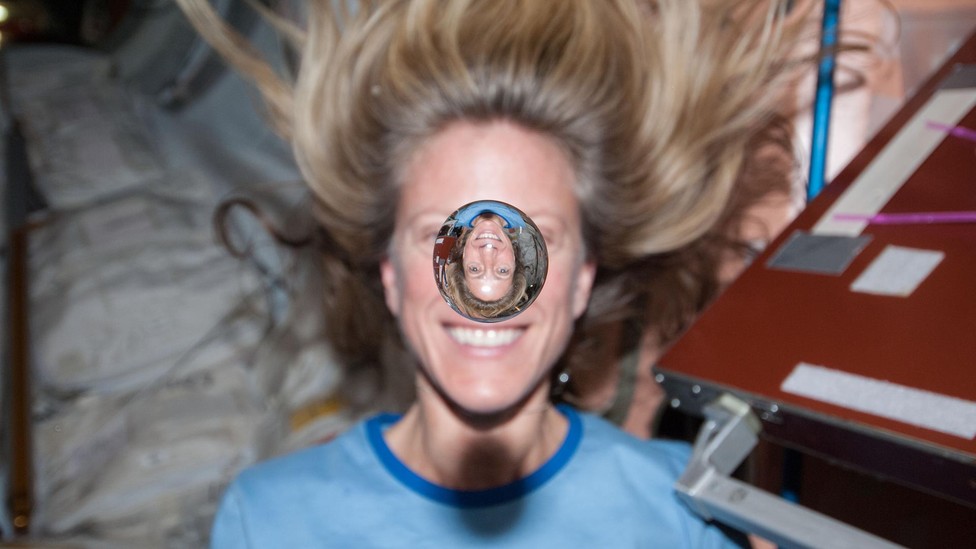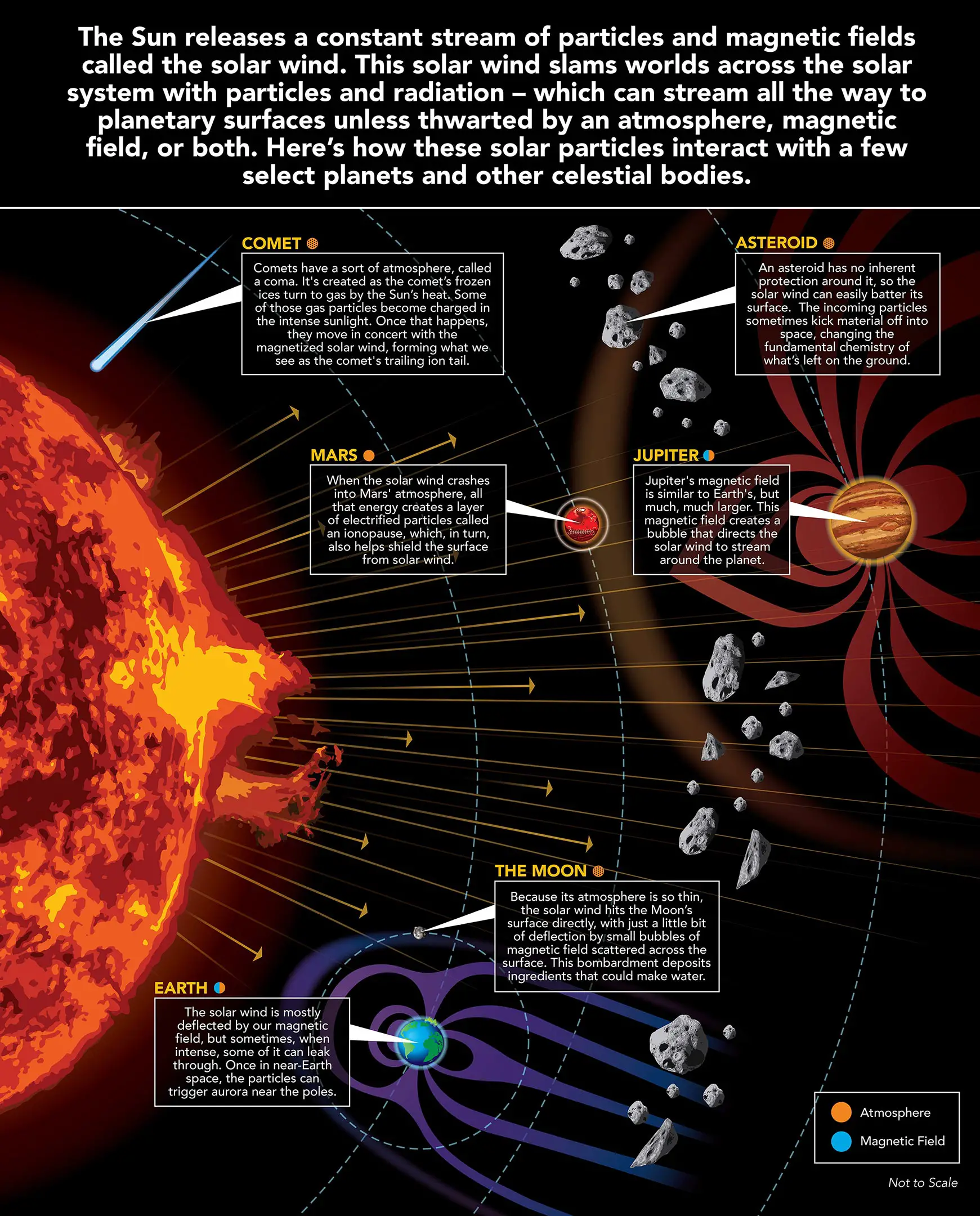You are using an out of date browser. It may not display this or other websites correctly.
You should upgrade or use an alternative browser.
You should upgrade or use an alternative browser.
Potentially interesting STEM stuff
- Thread starter Winston
- Start date

Help Support The Rocketry Forum:
This site may earn a commission from merchant affiliate
links, including eBay, Amazon, and others.
Winston
Lorenzo von Matterhorn
- Joined
- Jan 31, 2009
- Messages
- 9,560
- Reaction score
- 1,748
How deep is the vacuum in a fluorescent tube?
Same channel. He likes zapping things:
https://www.youtube.com/user/Photonvids/videos
Same channel. He likes zapping things:
https://www.youtube.com/user/Photonvids/videos
Winston
Lorenzo von Matterhorn
- Joined
- Jan 31, 2009
- Messages
- 9,560
- Reaction score
- 1,748
Could This Be the Mars Soviet 3 Lander?
https://www.nasa.gov/mission_pages/MRO/multimedia/pia16920.html
This set of images shows what might be hardware from the Soviet Union's 1971 Mars 3 lander, seen in a pair of images from the High Resolution Imaging Science Experiment (HiRISE) camera on NASA's Mars Reconnaissance Orbiter.
The possible Mars 3 lander hardware was found by an Internet group of Russian citizen enthusiasts who follow news about Mars and NASA's Curiosity rover.
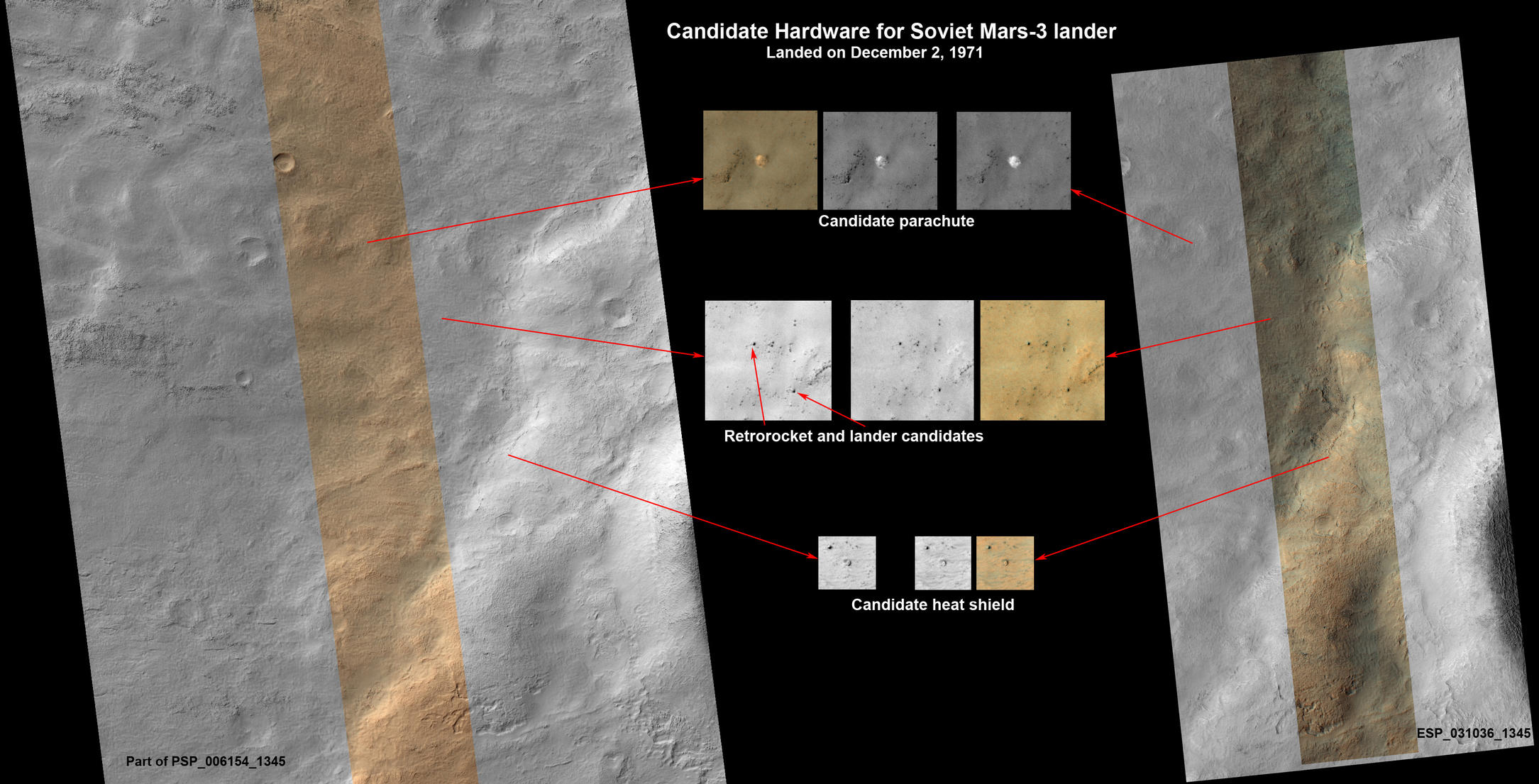
https://www.nasa.gov/mission_pages/MRO/multimedia/pia16920.html
This set of images shows what might be hardware from the Soviet Union's 1971 Mars 3 lander, seen in a pair of images from the High Resolution Imaging Science Experiment (HiRISE) camera on NASA's Mars Reconnaissance Orbiter.
The possible Mars 3 lander hardware was found by an Internet group of Russian citizen enthusiasts who follow news about Mars and NASA's Curiosity rover.

Winston
Lorenzo von Matterhorn
- Joined
- Jan 31, 2009
- Messages
- 9,560
- Reaction score
- 1,748
Science Launching on Northrop Grumman CRS-16 Mission to the Space Station
The Kentucky Re-Entry Universal Payload System (KRUPS): Orbital Flight
https://uknowledge.uky.edu/cgi/viewcontent.cgi?article=1175&context=me_etds
The Kentucky Re-Entry Universal Payload System (KRUPS): Orbital Flight
https://uknowledge.uky.edu/cgi/viewcontent.cgi?article=1175&context=me_etds
Winston
Lorenzo von Matterhorn
- Joined
- Jan 31, 2009
- Messages
- 9,560
- Reaction score
- 1,748
The ISS Backflipped Out of Control After Russian Module Misfired, New Details Reveal
https://gizmodo.com/the-iss-backflipped-out-of-control-after-russian-module-1847415359
The incident happened on Thursday, July 29, some three hours after Russia’s Nauka module docked to the space station. As Russian crew members worked to integrate the newly arrived section, Nauka’s thrusters began to fire, causing the ISS to roll backwards. Russian flight controllers eventually re-gained control, but, for a 47-minute span, the situation looked dicey.
At a press conference held later that day, NASA said the space station shifted by around 45 degrees. “That’s been a little incorrectly reported,” Zebulon Scoville, the NASA flight director in charge at the time, told the New York Times. The actual figure, he said, is closer to 540 degrees, which means the ISS performed 1.5 backflips, in an impromptu performance that would make an Olympic athlete jealous. When the ISS stopped spinning, it was fully upside down, requiring a 180-degree forward flip to regain the outpost’s original position, as the New York Times reports.
https://gizmodo.com/the-iss-backflipped-out-of-control-after-russian-module-1847415359
The incident happened on Thursday, July 29, some three hours after Russia’s Nauka module docked to the space station. As Russian crew members worked to integrate the newly arrived section, Nauka’s thrusters began to fire, causing the ISS to roll backwards. Russian flight controllers eventually re-gained control, but, for a 47-minute span, the situation looked dicey.
At a press conference held later that day, NASA said the space station shifted by around 45 degrees. “That’s been a little incorrectly reported,” Zebulon Scoville, the NASA flight director in charge at the time, told the New York Times. The actual figure, he said, is closer to 540 degrees, which means the ISS performed 1.5 backflips, in an impromptu performance that would make an Olympic athlete jealous. When the ISS stopped spinning, it was fully upside down, requiring a 180-degree forward flip to regain the outpost’s original position, as the New York Times reports.
Winston
Lorenzo von Matterhorn
- Joined
- Jan 31, 2009
- Messages
- 9,560
- Reaction score
- 1,748
Watch a Russian spacecraft burn up in Earth's atmosphere from space station
The Pirs docking compartment was ferried down to Earth's atmosphere by the Progress 77 spacecraft after undocking from the International Space Station on July 26, 2021. ESA astronaut Thomas Pesquet captured footage of its destruction during atmospheric reentry.
The Pirs docking compartment was ferried down to Earth's atmosphere by the Progress 77 spacecraft after undocking from the International Space Station on July 26, 2021. ESA astronaut Thomas Pesquet captured footage of its destruction during atmospheric reentry.
Winston
Lorenzo von Matterhorn
- Joined
- Jan 31, 2009
- Messages
- 9,560
- Reaction score
- 1,748
Space Collection - Part 1: Apollo LVDC Core Memory, Titan Missile Computer
Space Collection - Part 2: Apollo Fuel Cells, LM legs, MOCR Console, a piece of Mars and more!
Space Collection Part 3: Everyday Astronaut figures out the RL-10 Rocket Engine
Space Collection - Part 2: Apollo Fuel Cells, LM legs, MOCR Console, a piece of Mars and more!
Space Collection Part 3: Everyday Astronaut figures out the RL-10 Rocket Engine
Winston
Lorenzo von Matterhorn
- Joined
- Jan 31, 2009
- Messages
- 9,560
- Reaction score
- 1,748
What is the world’s deepest cave?
Time to meet the 'Everest of the deep'
https://www.zmescience.com/science/what-is-the-worlds-deepest-cave/
With a record depth of 2,212 meters (7,257 feet), the Verëvkina (Veryovkina) cave is the deepest cave measured thus far in the world. It’s located in the Arabika Massif in Abkhazia, a breakaway region of Georgia that is supported by Russia. Despite its complicated geopolitics, the region is home to not one but four of the deepest caves on Earth.
[snip]
Using a series of camps along the way, it took expedition members more than four days to reach the terminal sump at a depth of 2,212 meters (7,257 feet). It takes roughly the same time to return to the surface, so the crew had to spend at least a week inside, which is a very long time for such an extreme environment. Due to the endless night, the cavers easily break their biorhythms, working at night and sleeping during the day. Thankfully, communication links with a surface base allow the cavers to contact the outside world and share updates about their progress.
They had to descend thousands of feet on ropes and crawl through water- and mud-choked siphons. The cave goes down almost vertically and is full of wells with small horizontal passages. Starting from the depth of 800 meters (2,600 feet), water flowing through small tributaries splash water through the narrow passageways. This makes the cave extremely damp. The humidity is actually 100% and with a 4 °C to 7 °C temperature range, this means anyone descending will be freezing along the way.
Along the way, they collected samples of rare shrimp and scorpions, and possibly new species of microorganisms. There are also fossils, mainly imprinted on rocks, offering hints about how the cave's organisms might have looked millions of years ago, as well as how the cave itself and the surrounding mountains formed.
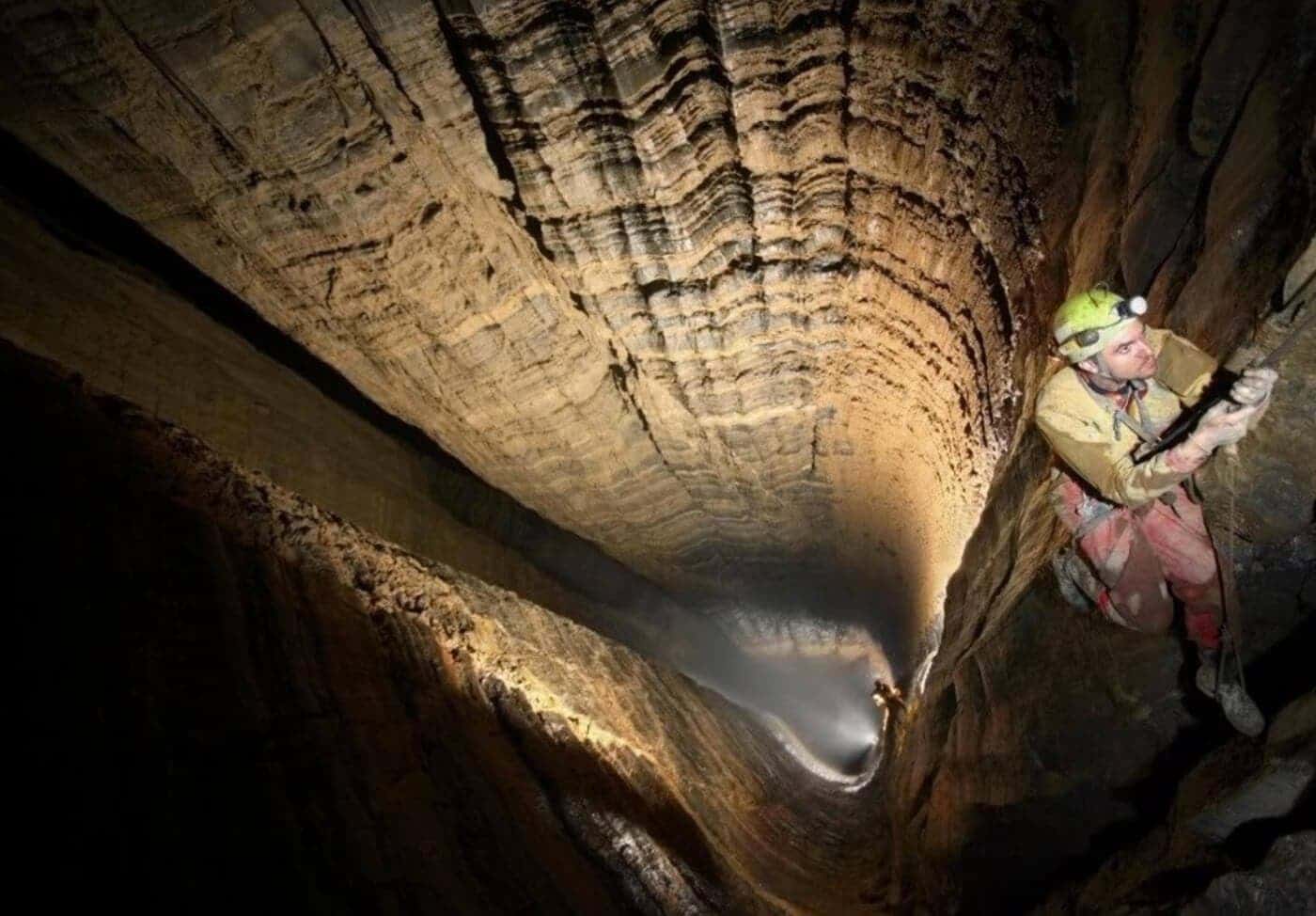
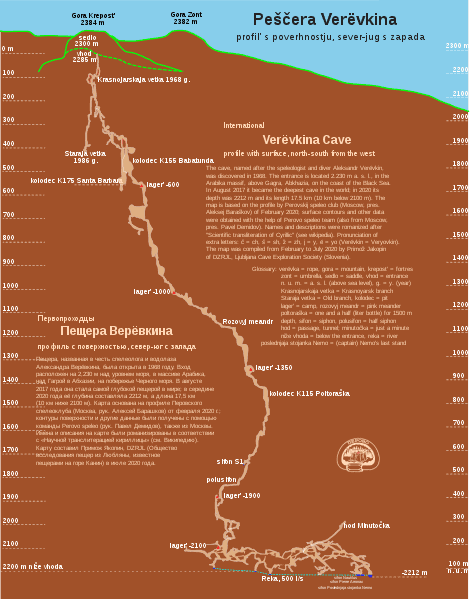
Time to meet the 'Everest of the deep'
https://www.zmescience.com/science/what-is-the-worlds-deepest-cave/
With a record depth of 2,212 meters (7,257 feet), the Verëvkina (Veryovkina) cave is the deepest cave measured thus far in the world. It’s located in the Arabika Massif in Abkhazia, a breakaway region of Georgia that is supported by Russia. Despite its complicated geopolitics, the region is home to not one but four of the deepest caves on Earth.
[snip]
Using a series of camps along the way, it took expedition members more than four days to reach the terminal sump at a depth of 2,212 meters (7,257 feet). It takes roughly the same time to return to the surface, so the crew had to spend at least a week inside, which is a very long time for such an extreme environment. Due to the endless night, the cavers easily break their biorhythms, working at night and sleeping during the day. Thankfully, communication links with a surface base allow the cavers to contact the outside world and share updates about their progress.
They had to descend thousands of feet on ropes and crawl through water- and mud-choked siphons. The cave goes down almost vertically and is full of wells with small horizontal passages. Starting from the depth of 800 meters (2,600 feet), water flowing through small tributaries splash water through the narrow passageways. This makes the cave extremely damp. The humidity is actually 100% and with a 4 °C to 7 °C temperature range, this means anyone descending will be freezing along the way.
Along the way, they collected samples of rare shrimp and scorpions, and possibly new species of microorganisms. There are also fossils, mainly imprinted on rocks, offering hints about how the cave's organisms might have looked millions of years ago, as well as how the cave itself and the surrounding mountains formed.


Winston
Lorenzo von Matterhorn
- Joined
- Jan 31, 2009
- Messages
- 9,560
- Reaction score
- 1,748
JULY 30, 2021
Apollo 11 ascent stage may still be orbiting the moon
https://phys.org/news/2021-07-apollo-ascent-stage-orbiting-moon.html
Meador began his investigation by considering whether it might be possible to find the ascent stage, which he assumed would be on the surface of the moon. He noted that NASA had sent spacecraft into orbit around the moon in 2012 as part of the GRAIL project to map the moon's gravitational field. That suggested he should be able to track the ascent stage's descent to the moon using a tool created by NASA called the General Mission Analysis Tool, which can be used to map spacecraft trajectories around planets or moons when their gravitational field is known.
After adding data from GRAIL, Meador ran the simulation multiple times using different parameters to simulate conditions that likely existed from the time when the ascent was jettisoned on up to the present. He also included data to take into account gravity from the sun and the other planets (except Mercury) and data describing forces due to solar radiation. He found that all of his simulations showed the ascent stage maintaining a steady orbit.
Meador acknowledges that other factors could have led to the demise of the craft—its remaining fuel could have exploded as the craft degraded, for example, changing its orbit. But he also notes that if the agency chooses to look for it, NASA possesses the technology needed to find the craft if it is still in orbit.
Long-term Orbit Stability of the Apollo 11 Eagle Lunar Module Ascent Stage
https://arxiv.org/pdf/2105.10088.pdf
Apollo 11 ascent stage may still be orbiting the moon
https://phys.org/news/2021-07-apollo-ascent-stage-orbiting-moon.html
Meador began his investigation by considering whether it might be possible to find the ascent stage, which he assumed would be on the surface of the moon. He noted that NASA had sent spacecraft into orbit around the moon in 2012 as part of the GRAIL project to map the moon's gravitational field. That suggested he should be able to track the ascent stage's descent to the moon using a tool created by NASA called the General Mission Analysis Tool, which can be used to map spacecraft trajectories around planets or moons when their gravitational field is known.
After adding data from GRAIL, Meador ran the simulation multiple times using different parameters to simulate conditions that likely existed from the time when the ascent was jettisoned on up to the present. He also included data to take into account gravity from the sun and the other planets (except Mercury) and data describing forces due to solar radiation. He found that all of his simulations showed the ascent stage maintaining a steady orbit.
Meador acknowledges that other factors could have led to the demise of the craft—its remaining fuel could have exploded as the craft degraded, for example, changing its orbit. But he also notes that if the agency chooses to look for it, NASA possesses the technology needed to find the craft if it is still in orbit.
Long-term Orbit Stability of the Apollo 11 Eagle Lunar Module Ascent Stage
https://arxiv.org/pdf/2105.10088.pdf
Winston
Lorenzo von Matterhorn
- Joined
- Jan 31, 2009
- Messages
- 9,560
- Reaction score
- 1,748
Humorous and well produced presentation. Unit is named "Retina Obliterator" and he found somewhere (or made) a joke laser emissions warning sticker (in brail) to put on it.
Homemade CO2 Laser Tube
Homemade CO2 Laser Tube Part 2
DIY Control Unit For My Co2 Laser Tube
DIY CNC Laser Cutter Part 1 - Main Frame And Z Axis
DIY CNC Laser Cutter Part 2 - Making X And Y The Gantry
DIY CNC Laser Cutter Part 3 - Mirror Mounts And Enclosure
https://www.youtube.com/watch?v=8jB7CLWZdGI
Homemade CO2 Laser Tube
Homemade CO2 Laser Tube Part 2
DIY Control Unit For My Co2 Laser Tube
DIY CNC Laser Cutter Part 1 - Main Frame And Z Axis
DIY CNC Laser Cutter Part 2 - Making X And Y The Gantry
DIY CNC Laser Cutter Part 3 - Mirror Mounts And Enclosure
https://www.youtube.com/watch?v=8jB7CLWZdGI
Winston
Lorenzo von Matterhorn
- Joined
- Jan 31, 2009
- Messages
- 9,560
- Reaction score
- 1,748
Winston
Lorenzo von Matterhorn
- Joined
- Jan 31, 2009
- Messages
- 9,560
- Reaction score
- 1,748
How NBC Packed an Entire 1950s TV Studio Into a Cadillac
Today, major news stations dispatch vans filled with complex broadcasting equipment to capture the latest. In 1953, NBC used a swanky Cadillac limousine. Here's how.
29 Jul 2021
https://www.popularmechanics.com/culture/movies/a36388017/nbc-1950s-cadillac
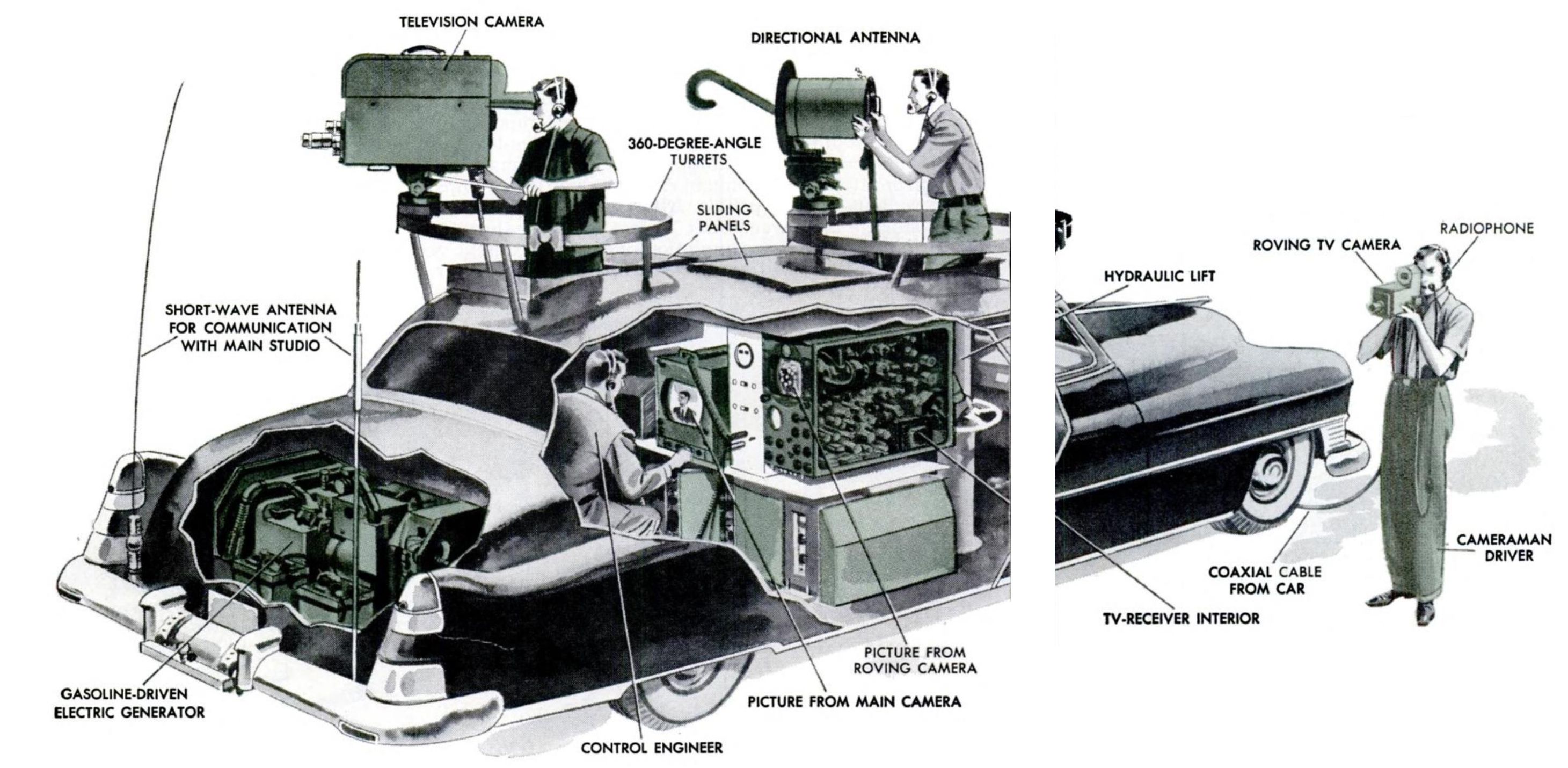
Today, major news stations dispatch vans filled with complex broadcasting equipment to capture the latest. In 1953, NBC used a swanky Cadillac limousine. Here's how.
29 Jul 2021
https://www.popularmechanics.com/culture/movies/a36388017/nbc-1950s-cadillac

Winston
Lorenzo von Matterhorn
- Joined
- Jan 31, 2009
- Messages
- 9,560
- Reaction score
- 1,748
Moon lacked a magnetic field for nearly all its history – new research resolves mystery sparked by rocks brought back on Apollo
4 Aug 2021
https://theconversation.com/moon-la...k-on-apollo-163243?utm_source=DamnInteresting
In the 1980s, geophysicists studying rocks brought back by Apollo astronauts concluded the Moon once had a magnetic field that was as strong as Earth’s. But a robust magnetic field requires a power source, and the Moon’s core is relatively small. For decades, scientists have struggled to resolve this conundrum: how could such a small core create a strong magnetic field?
4 Aug 2021
https://theconversation.com/moon-la...k-on-apollo-163243?utm_source=DamnInteresting
In the 1980s, geophysicists studying rocks brought back by Apollo astronauts concluded the Moon once had a magnetic field that was as strong as Earth’s. But a robust magnetic field requires a power source, and the Moon’s core is relatively small. For decades, scientists have struggled to resolve this conundrum: how could such a small core create a strong magnetic field?
Winston
Lorenzo von Matterhorn
- Joined
- Jan 31, 2009
- Messages
- 9,560
- Reaction score
- 1,748
Can Life Exist on a Rogue Planet?
With the right conditions and a bit of luck, some of the most inhospitable worlds in the universe could still be habitable.
Aug 12, 2021
https://www.discovermagazine.com/the-sciences/can-life-exist-on-a-rogue-planet
With the right conditions and a bit of luck, some of the most inhospitable worlds in the universe could still be habitable.
Aug 12, 2021
https://www.discovermagazine.com/the-sciences/can-life-exist-on-a-rogue-planet
Winston
Lorenzo von Matterhorn
- Joined
- Jan 31, 2009
- Messages
- 9,560
- Reaction score
- 1,748
JPL's Plan For The Next Mars Helicopter After Ingenuity's success, JPL wants to go much, much bigger
10 AUG 2021
https://spectrum.ieee.org/the-next-mars-helicopter
The current MSH concept has a mass of about 31 kg and a total diameter of just over four meters, with six rotors each sporting a quartet of 0.64 meter blades. The payload of 5 kg gives MSH what Balaram calls a very attractive sweet spot for science instruments. MSH would have a top speed of about 30 m/s, a five minute hover time, or a range of up to 10km per flight, and a solar cell on top of the vehicle would be able to recharge MSH's batteries over the course of one Martian day. This kind of range and speed means that MSH could cover as much ground in a few days as a rover like Curiosity has covered in years. JPL and its partners have also been working on things like blade design, manufacturability, and how MSH would fold up inside of an aeroshell for entry, descent, and landing. There's even the exciting possibility of a mid-air deployment as part of the landing process, which would avoid the additional cost and complexity of a dedicated lander.
Since much of the work done on the Mars Science Helicopter took place before Perseverance and Ingenuity landed on Mars, the MSH team has been learning a lot about Martian rotorcraft operations from how Ingenuity has been performing over the last several months, which in turn is informing design decisions about MSH. "One of the main unknowns that we had was how much we could rely upon orbital images to pick landing sites," Balaram says. Ingenuity has shown that orbital images are actually pretty good for this, and even with relatively low resolution images, finding safe landing fields is fairly reliable. This means MSH might not need quite as sophisticated of a hazard detection system for making autonomous landings, simplifying the design and saving mass. Ingenuity's experience has also given the MSH team more confidence about flying in windy conditions. "In terms of the control performance, Ingenuity has turned out to be exceeding our expectations," says Balaram, which translates into potentially tuning the performance of MSH to be a little less conservative. "It's kind of like, let's just relax our design margins, because some of the tough problems that we thought were tough are probably not as challenging as we thought they could be. So those lessons learned feed forward into the science helicopter."
Ingenuity has also shown how modern computing hardware and software can be used in spacecraft. Its technology demo status meant that JPL could get a little more creative than normal, using a Qualcomm Snapdragon 801 running Linux which gave the little helicopter 150 times more computing power than the Perseverance rover. Balaram wants to leverage Ingenuity's success into a similar approach with MSH: "One of the things that we demonstrated with Ingenuity is even though it was a technology demo, we could still build in the right amount of redundancy through clever computing architecture. You can imagine using processors that may be slightly fragile from a radiation perspective, but that use a voting system to make decisions, running three of them in parallel. It's a way of thinking about how we want to do computing that isn't insisting on bulletproof hardware from the 90s—it's still conservative, just not necessarily the old way of doing things. And there's no fundamental reason why these kinds of things cannot be done in the next generation helicopter."
If the idea of a flagship helicopter-only mission to Mars seems far-fetched, it's important to remember that NASA's first rover on Mars was also a small technology demonstrator: Sojourner. With an initial mission length of seven Martian days, Sojourner stayed active for 83 days, and helped to give NASA the experience and confidence required to send first the Spirit and Opportunity rovers, and then the Curiosity and Perseverance rovers, to Mars.
Mars Science Helicopter
https://mepag.jpl.nasa.gov/reports/decadal2023-2032/MSH_whitepaper_draft_final copy.pdf
Mars Science Helicopter Conceptual Design
https://rotorcraft.arc.nasa.gov/Publications/files/MSH_WJohnson_TM2020rev.pdf

10 AUG 2021
https://spectrum.ieee.org/the-next-mars-helicopter
The current MSH concept has a mass of about 31 kg and a total diameter of just over four meters, with six rotors each sporting a quartet of 0.64 meter blades. The payload of 5 kg gives MSH what Balaram calls a very attractive sweet spot for science instruments. MSH would have a top speed of about 30 m/s, a five minute hover time, or a range of up to 10km per flight, and a solar cell on top of the vehicle would be able to recharge MSH's batteries over the course of one Martian day. This kind of range and speed means that MSH could cover as much ground in a few days as a rover like Curiosity has covered in years. JPL and its partners have also been working on things like blade design, manufacturability, and how MSH would fold up inside of an aeroshell for entry, descent, and landing. There's even the exciting possibility of a mid-air deployment as part of the landing process, which would avoid the additional cost and complexity of a dedicated lander.
Since much of the work done on the Mars Science Helicopter took place before Perseverance and Ingenuity landed on Mars, the MSH team has been learning a lot about Martian rotorcraft operations from how Ingenuity has been performing over the last several months, which in turn is informing design decisions about MSH. "One of the main unknowns that we had was how much we could rely upon orbital images to pick landing sites," Balaram says. Ingenuity has shown that orbital images are actually pretty good for this, and even with relatively low resolution images, finding safe landing fields is fairly reliable. This means MSH might not need quite as sophisticated of a hazard detection system for making autonomous landings, simplifying the design and saving mass. Ingenuity's experience has also given the MSH team more confidence about flying in windy conditions. "In terms of the control performance, Ingenuity has turned out to be exceeding our expectations," says Balaram, which translates into potentially tuning the performance of MSH to be a little less conservative. "It's kind of like, let's just relax our design margins, because some of the tough problems that we thought were tough are probably not as challenging as we thought they could be. So those lessons learned feed forward into the science helicopter."
Ingenuity has also shown how modern computing hardware and software can be used in spacecraft. Its technology demo status meant that JPL could get a little more creative than normal, using a Qualcomm Snapdragon 801 running Linux which gave the little helicopter 150 times more computing power than the Perseverance rover. Balaram wants to leverage Ingenuity's success into a similar approach with MSH: "One of the things that we demonstrated with Ingenuity is even though it was a technology demo, we could still build in the right amount of redundancy through clever computing architecture. You can imagine using processors that may be slightly fragile from a radiation perspective, but that use a voting system to make decisions, running three of them in parallel. It's a way of thinking about how we want to do computing that isn't insisting on bulletproof hardware from the 90s—it's still conservative, just not necessarily the old way of doing things. And there's no fundamental reason why these kinds of things cannot be done in the next generation helicopter."
If the idea of a flagship helicopter-only mission to Mars seems far-fetched, it's important to remember that NASA's first rover on Mars was also a small technology demonstrator: Sojourner. With an initial mission length of seven Martian days, Sojourner stayed active for 83 days, and helped to give NASA the experience and confidence required to send first the Spirit and Opportunity rovers, and then the Curiosity and Perseverance rovers, to Mars.
Mars Science Helicopter
https://mepag.jpl.nasa.gov/reports/decadal2023-2032/MSH_whitepaper_draft_final copy.pdf
Mars Science Helicopter Conceptual Design
https://rotorcraft.arc.nasa.gov/Publications/files/MSH_WJohnson_TM2020rev.pdf

Winston
Lorenzo von Matterhorn
- Joined
- Jan 31, 2009
- Messages
- 9,560
- Reaction score
- 1,748
Russia’s space program just threw a NASA astronaut under the bus
12 Aug 2021
https://arstechnica.com/science/202...am-just-threw-a-nasa-astronaut-under-the-bus/
Russia's state-owned news service, TASS, has published an extraordinarily defamatory article about NASA astronaut Serena Auñón-Chancellor. The publication claims that Auñón-Chancellor had an emotional breakdown in space, then damaged a Russian spacecraft in order to return early. This, of course, is a complete fabrication.
The context for the article is the recent, near-disastrous docking of the Russian Nauka science module with the International Space Station. The TASS article attempts to rebut criticism in US publications (including Ars Technica) that covered the incident and raised questions about the future of the Roscosmos-NASA partnership in space.
One of a dozen rebuttals in the TASS article concerns a 2018 incident—a 2 mm breach in the orbital module of the Soyuz MS-09 vehicle docked with the International Space Station. Russian cosmonaut Sergey Prokopyev, European Space Agency astronaut Alexander Gerst, and NASA's Auñón-Chancellor had flown to the station inside this Soyuz in June. The leak was discovered in late August.
Left unchecked, the small hole would have depressurized the station in about two weeks. Fortunately, cosmonauts were able to patch the hole with epoxy, and the Soyuz spacecraft was deemed safe to fly its crew of three back to Earth.
12 Aug 2021
https://arstechnica.com/science/202...am-just-threw-a-nasa-astronaut-under-the-bus/
Russia's state-owned news service, TASS, has published an extraordinarily defamatory article about NASA astronaut Serena Auñón-Chancellor. The publication claims that Auñón-Chancellor had an emotional breakdown in space, then damaged a Russian spacecraft in order to return early. This, of course, is a complete fabrication.
The context for the article is the recent, near-disastrous docking of the Russian Nauka science module with the International Space Station. The TASS article attempts to rebut criticism in US publications (including Ars Technica) that covered the incident and raised questions about the future of the Roscosmos-NASA partnership in space.
One of a dozen rebuttals in the TASS article concerns a 2018 incident—a 2 mm breach in the orbital module of the Soyuz MS-09 vehicle docked with the International Space Station. Russian cosmonaut Sergey Prokopyev, European Space Agency astronaut Alexander Gerst, and NASA's Auñón-Chancellor had flown to the station inside this Soyuz in June. The leak was discovered in late August.
Left unchecked, the small hole would have depressurized the station in about two weeks. Fortunately, cosmonauts were able to patch the hole with epoxy, and the Soyuz spacecraft was deemed safe to fly its crew of three back to Earth.




